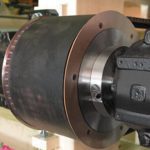Jackscrews (also referred to as jack screws or screw jacks) are among several different kinds of linear motion actuators most often used for lifting or moving loads. They can also be used in any application needing linear motion, or where pushing or pulling along a linear axis is needed. Other common mechanical actuators include lead, ball, and roller screws.
A few basic components comprise a jackscrew. The main piece is the screw itself. The screw may be connected to a plate of some kind housing a load or attached to another piece of machinery that is then moved. Sometimes instead of a plate there is an attached nut or nut flange so that the screw is stationary and only the nut assembly moves. There is also a stationary base unit housing gears.

One of the most familiar kinds of jackscrews are the traditional manually powered, hand-turned types, which operate by applying force against a handle which makes the screw rise from a base unit, lifting or lowering a load. Other common means of driving jackscrews are either ac or dc motors.
There are a few other ways of classifying jackscrews as well. One of them divides screws into translating and rotating types. Translating jackscrews use a lift shaft or screw that travels into or out from a worm gear box. The lift shaft can either protrude from the mounting flange side of the gearbox or from the top side of the worm gear box. In contrast, rotating jackscrews are designed so that the lift shaft remains stationary and a lifting nut moves along the lift shaft. Like with translating jackscrews, the screw can protrude down from the mounting flange or up from the top of the jack. To produce translation of the lift shaft or nut, both configurations must be secured to prevent rotation.
Another way some manufacturers differentiate between jackscrews is by the screw type. For instance, is the jackscrew a ball jackscrew or a machine jackscrew? Ball jackscrews use a ball screw and nut, which means that hardened balls carry the load between the nut and screw. Because of the use of a ball screw, the rolling action reduces friction, making for smooth and efficient movement of the load. Machine jackscrews, on the other hand, typically use acme screws. This makes them better suited for moving heavier loads in lower speed applications.






Leave a Reply
You must be logged in to post a comment.